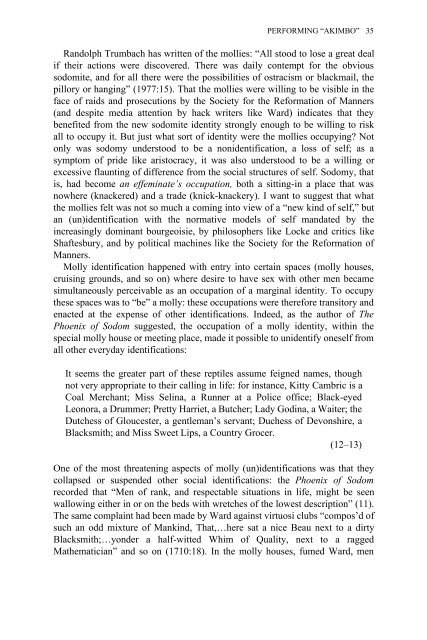Edited by Moe Meyer - Get a Free Blog
Edited by Moe Meyer - Get a Free Blog
Edited by Moe Meyer - Get a Free Blog
You also want an ePaper? Increase the reach of your titles
YUMPU automatically turns print PDFs into web optimized ePapers that Google loves.
PERFORMING “AKIMBO” 35<br />
Randolph Trumbach has written of the mollies: “All stood to lose a great deal<br />
if their actions were discovered. There was daily contempt for the obvious<br />
sodomite, and for all there were the possibilities of ostracism or blackmail, the<br />
pillory or hanging” (1977:15). That the mollies were willing to be visible in the<br />
face of raids and prosecutions <strong>by</strong> the Society for the Reformation of Manners<br />
(and despite media attention <strong>by</strong> hack writers like Ward) indicates that they<br />
benefited from the new sodomite identity strongly enough to be willing to risk<br />
all to occupy it. But just what sort of identity were the mollies occupying? Not<br />
only was sodomy understood to be a nonidentification, a loss of self; as a<br />
symptom of pride like aristocracy, it was also understood to be a willing or<br />
excessive flaunting of difference from the social structures of self. Sodomy, that<br />
is, had become an effeminate’s occupation, both a sitting-in a place that was<br />
nowhere (knackered) and a trade (knick-knackery). I want to suggest that what<br />
the mollies felt was not so much a coming into view of a “new kind of self,” but<br />
an (un)identification with the normative models of self mandated <strong>by</strong> the<br />
increasingly dominant bourgeoisie, <strong>by</strong> philosophers like Locke and critics like<br />
Shaftesbury, and <strong>by</strong> political machines like the Society for the Reformation of<br />
Manners.<br />
Molly identification happened with entry into certain spaces (molly houses,<br />
cruising grounds, and so on) where desire to have sex with other men became<br />
simultaneously perceivable as an occupation of a marginal identity. To occupy<br />
these spaces was to “be” a molly: these occupations were therefore transitory and<br />
enacted at the expense of other identifications. Indeed, as the author of The<br />
Phoenix of Sodom suggested, the occupation of a molly identity, within the<br />
special molly house or meeting place, made it possible to unidentify oneself from<br />
all other everyday identifications:<br />
It seems the greater part of these reptiles assume feigned names, though<br />
not very appropriate to their calling in life: for instance, Kitty Cambric is a<br />
Coal Merchant; Miss Selina, a Runner at a Police office; Black-eyed<br />
Leonora, a Drummer; Pretty Harriet, a Butcher; Lady Godina, a Waiter; the<br />
Dutchess of Gloucester, a gentleman’s servant; Duchess of Devonshire, a<br />
Blacksmith; and Miss Sweet Lips, a Country Grocer.<br />
(12–13)<br />
One of the most threatening aspects of molly (un)identifications was that they<br />
collapsed or suspended other social identifications: the Phoenix of Sodom<br />
recorded that “Men of rank, and respectable situations in life, might be seen<br />
wallowing either in or on the beds with wretches of the lowest description” (11).<br />
The same complaint had been made <strong>by</strong> Ward against virtuosi clubs “compos’d of<br />
such an odd mixture of Mankind, That,…here sat a nice Beau next to a dirty<br />
Blacksmith;…yonder a half-witted Whim of Quality, next to a ragged<br />
Mathematician” and so on (1710:18). In the molly houses, fumed Ward, men


